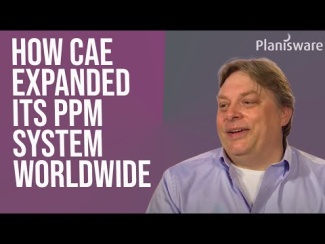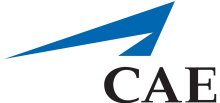X
My name is Daniel Normand. I'm the IT systems expert for Planisware at CAE.
What does CAE do and what is its mission? (0:13 to 0:35)
CAE enjoys a long history of leadership in the aviation industry as far as flight simulator manufacturing is concerned. But, in the past decade, we were … we ventured in the service industry, which was a very successful activity and, recently, we nimbled into the healthcare simulation-based training.
What does CAE use Planisware for and what is its scope of use? (0:38 to 1:20)
Every project that we have is a deliverable, it's a contract we signed with a customer. So, we have a large number of projects. There's 5400-plus projects, 2400 … around 2400 of them receive costs during any given month, so it's quite a large portfolio. Another thing I was surprised to find out when I looked at the metrics is that out of the 575 users that we have, more than 90 percent of them did connect in the last quarter. So, it's pretty much used across the board by all the users that registered.
What is your role within the organization as it pertains to Planisware? (1:24 to 01:48)
So, my main function is to interface with the business and try to determine what improvement we can make to the system to take out the non-value added activities and allow the system to automate those, if that can be automated, or at least to make the job easier for those people that are monitoring or updating the projects.
What problems are you solving by using Planisware? (01:49 to 03:09)
So, we were looking to a front-end to the expansion of the Oracle e-business suite that we were adding the project accounting module, and Planisware was selected as the user interface for that system.
We had a number of outdated, homegrown systems. They were not interfacing very well together and we needed something to be more live.
More importantly, we wanted to have a system that would allow us to have the possibility to make decisions with live data.
One of the uniqueness of our implementation is that we planned the cost at an average rate and when projects collect costs, they collect the costs at the actual rate of the person that worked on it. This invariably creates a delta between the planning and the actuals, and what we want to do is to separate the part that is rate-related to the real efficiencies or inefficiencies in the execution of a given deliverable. So, Planisware was very useful in helping us to develop that ability to isolate the rate impact from the actual performance metrics.
How did CAE expand system use to other regional affiliates? (03:11 to 03:59)
This was always the plan from the beginning. We had a multi-year plan to have Planisware first in the headquarters and to all of the outfits where we have engineering capabilities, but due to priorities, that was postponed, so we recently started that planned event with a little delay, but we're rolling them out.
We first started with other offices in Canada, outside of Montreal, that was the easiest because we were all running on the same currency. And then we had our Australian office and we obviously had some additional challenges because of the multi-organization, multi-currency necessities and requirements.
What were some of the biggest challenges in doing this? (04:04 to 04:38)
Each region has its particularity. When we went to our other Canadian offices, there was a need to manage at the named resource level and when we moved over to Australia, then the currency -- or multi-functionality -- was a challenge. So, as we roll them out, we expect to find, always, local requirements that we need to adapt to and the fact that Planisware can adapt easily -- and we do have support from the consultant team -- allows us to progress pretty seamlessly.
How did you adapt the system to your regional requirements? (04:41 to 05:27)
For the Canada region, we needed to be able to address their need to be able to manage their resources, which was a much smaller pool than the Montreal user community or employee pool, at the named resource. So, we use generic resource in Montreal and because of their nature, the way they provide services and need to build by the name, we needed to introduce the named resource management. As far as Australia is concerned, well, it was our first application of running projects within the same instance with two different functional currencies. So, we needed to be able to support that in parallel within the same instance of Planisware.
What built-in functionality helped to adapt user experience by region? (05:31 to 06:02)
There was some built-in functionality, so there is a operational unit attribute, but we had not exploited it so far. Everything was CAE, Inc. And now we had to introduce CAE Australia and CAE New Zealand, and all of our reports were in Canadian dollars to start with. And now we had to adapt the reports so that the same report will show different currencies, depending what operational unit is using it.
Are you planning to expand to other regions? (06:06 to 06:47)
So, we do have a plan right now to expand to our European offices, namely Germany and the U.K., possibly some others, because we're in the very initial stages of scoping. The plan is to roll them out within the coming 12-18 months.
One of the requirements in Germany that's new from the other rollouts we did is that English is not the main language, so we do need to support German language and it's something that's easily configurable in Planisware -- we just need to have a local validate the translations. And put that in the table and we expect everything to be fine.
How has the roll out been accepted? (06:50 to 07:31)
When we started in the head office, this was a corporate decision of moving to an integrated system and we faced the usual challenge of change management. However, in the rollout in our smaller outfits, many of them were relying on outdated tools or systems that were actually barely still functioning. So, there was a need from the users -- they were pulling on this rather than the headquarters pushing down their throat. So, it was a very interesting, or refreshing, way of rolling out the application.
What does business as usual look like and how often is Planisware used? (07:34 to 08:28)
So, we already had a monthly project review cycle and it was well-instated in the company, and when we rolled in Planisware, we built on that process. And the typical monthly is getting cost imported into the tool on a weekly basis, and workpackage manager will review the progress of their workpackage and make up to do the remaining work, and during the last week of the month, each project manager would analyze the impact of all of those people and make adjustments to whatever budgets are necessary. And the last two days of our cycle is review with the program managers and our finance team to make sure the numbers all hold water, and that they're good for publication.
What benefits has CAE experienced since going live? (08:32 to 09:16)
Being an integrated tool, we no longer were managing milestones and financial forecasting and manloading in isolation anymore. Everything was derivative of the other in a single, integrated environment.
So, working directly in the same tool that is feeding off a number of satellite systems is really a large benefit. It allows us to have data that we know is accurate and that is fed to the other systems that depend on it.
We now have a single source of the truth and we know that it's up-to-date at all times, as opposed to extracted from files that have been manipulated. So, that, in itself, is kind of invaluable.
How do you see CAE and Planisware working together in the future? (09:20 to 10:05)
When we invested in Planisware, this was a long-term decision. We had the intention to roll this out to all of our organizations, so it's a commitment that we made. And I can see, easily, new features that are being published on a regular basis, like the use of Agile, which was originally in our scope, but now has been ... is now a lot more mature than it used to be. Or other, standard, out-of-the-box features like the risk module that we implemented that is simply built on best practices and resembled a lot of the homegrown tool we were using on the side -- we just decommissioned that and used Planisware risk module and it was a seamless integration.

